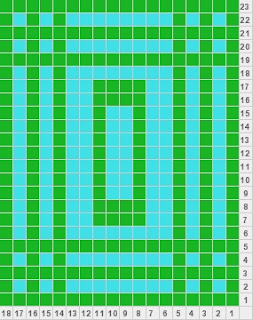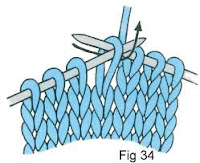glad for circular knitting. It truly is a gift from above.
Circular knitting is when you use double pointed needles or a circular needle to knit the pieces in the shape of a tube. You can add increasing, decreasing, pattern stitches, and colorwork just like regular knitting so it's pretty easy to learn!
The first method I'm going to show you is using a circular needle. This is extremely easy to do especially after a bit of practice. Circular needles are basically just two short needles connect by a long thin cord made of some type of plastic. The package they come in will tell you two measurements: length and needle size. They look like this:
 Using them is really easy. Just cast on the number of stitches you need (the length of the needle will depend on the nber if stitches).
Using them is really easy. Just cast on the number of stitches you need (the length of the needle will depend on the nber if stitches).
 Put a marker on the end of the RH needle so you know where one round (circular rows are called rounds aka rnds) ends and the next starts.
Connect the ends start working the stitches that were cast on first
Put a marker on the end of the RH needle so you know where one round (circular rows are called rounds aka rnds) ends and the next starts.
Connect the ends start working the stitches that were cast on first
 MAKE SURE THE STITCHES ARE NOT TWISTED. If they are and you keep going without fixing it you will have to unravel all your work and redo it. Not fun, my friends. Not fun at all. So if the stitches are twisted, untwist them and then start knitting. Just go around the circle until you get to the marker. Then just slip the marker from LH needle to RH needle and keep going! Simple!
MAKE SURE THE STITCHES ARE NOT TWISTED. If they are and you keep going without fixing it you will have to unravel all your work and redo it. Not fun, my friends. Not fun at all. So if the stitches are twisted, untwist them and then start knitting. Just go around the circle until you get to the marker. Then just slip the marker from LH needle to RH needle and keep going! Simple!
 Using them is really easy. Just cast on the number of stitches you need (the length of the needle will depend on the nber if stitches).
Using them is really easy. Just cast on the number of stitches you need (the length of the needle will depend on the nber if stitches). Put a marker on the end of the RH needle so you know where one round (circular rows are called rounds aka rnds) ends and the next starts.
Put a marker on the end of the RH needle so you know where one round (circular rows are called rounds aka rnds) ends and the next starts.  MAKE SURE THE STITCHES ARE NOT TWISTED. If they are and you keep going without fixing it you will have to unravel all your work and redo it. Not fun, my friends. Not fun at all. So if the stitches are twisted, untwist them and then start knitting. Just go around the circle until you get to the marker. Then just slip the marker from LH needle to RH needle and keep going! Simple!
MAKE SURE THE STITCHES ARE NOT TWISTED. If they are and you keep going without fixing it you will have to unravel all your work and redo it. Not fun, my friends. Not fun at all. So if the stitches are twisted, untwist them and then start knitting. Just go around the circle until you get to the marker. Then just slip the marker from LH needle to RH needle and keep going! Simple!
So that's pretty much it. I'm going to save the Double Pointed needles for the next post.
So now I'm going to make a little tribute to a YouTuber named Connor Franta. He's amazing. If you watch his videos you will understand this next part.
Okeyyyy I'm gonna go! So today we talked about knitting in circles an circular knitting and yarn and needles and I don't even know what Wbsognrks bouyyyyye!!!!















.jpg)
.jpg)
.jpg)





.jpg)
.jpg)
.jpg)
.jpg)

.jpg)



